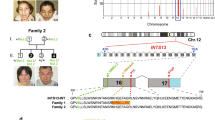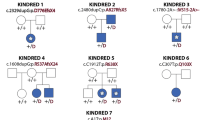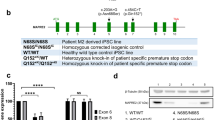Abstract
The oral-facial-digital type I (OFD1) syndrome (OMIM 311200) is a human developmental disorder; affected individuals have craniofacial and digital abnormalities and, in 15% of cases, polycystic kidney1,2. The disease is inherited as an X-linked dominant male-lethal trait. Using a Cre-loxP system, we generated knockout animals lacking Ofd1 and reproduced the main features of the disease, albeit with increased severity, possibly owing to differences of X inactivation patterns between human and mouse. We found failure of left-right axis specification in mutant male embryos, and ultrastructural analysis showed a lack of cilia in the embryonic node. Formation of cilia was defective in cystic kidneys from heterozygous females, implicating ciliogenesis as a mechanism underlying cyst development. In addition, we found impaired patterning of the neural tube and altered expression of the 5′ Hoxa and Hoxd genes in the limb buds of mice lacking Ofd1, suggesting that Ofd1 could have a role beyond primary cilium organization and assembly.
This is a preview of subscription content, access via your institution
Access options
Subscribe to this journal
Receive 12 print issues and online access
We are sorry, but there is no personal subscription option available for your country.
Buy this article
- Purchase on SpringerLink
- Instant access to full article PDF
Prices may be subject to local taxes which are calculated during checkout






Similar content being viewed by others
References
Gorlin, R.J. Oro-facio-digital syndrome 1. in Birth Defects Encyclopedia Vol. 2 (ed. Buyse, M.L.) 1309–1310 (Center for Birth Defects Information Services, Dover, Massachusetts, 1990).
Feather, S.A., Winyard, P.J., Dodd, S. & Woolf, A.S. Oral-facial-digital syndrome type 1 is another dominant polycystic kidney disease: clinical, radiological and histopathological features of a new kindred. Nephrol. Dial. Transplant. 12, 1354–1361 (1997).
Ferrante, M.I. et al. Identification of the gene for oral-facial-digital type I syndrome. Am. J. Hum. Genet. 68, 569–576 (2001).
de Conciliis, L. et al. Characterization of Cxorf5 (71–7A), a novel human cDNA mapping to Xp22 and encoding a protein containing coiled-coil α-helical domains. Genomics 51, 243–250 (1998).
Romio, L. et al. OFD1 is a centrosomal/basal body protein expressed during mesenchymal-epithelial transition in human nephrogenesis. J. Am. Soc. Nephrol. 15, 2556–2568 (2004).
Ferrante, M.I. et al. Characterization of the OFD1/Ofd1 genes on the human and mouse sex chromosomes and exclusion of Ofd1 for the Xpl mouse mutant. Genomics 81, 560–569 (2003).
Nagy, A. Cre recombinase: the universal reagent for genome tailoring. Genesis 26, 99–109 (2000).
Watnick, T. & Germino, G. From cilia to cyst. Nat. Genet. 34, 355–356 (2003).
Hamada, H., Meno, C., Watanabe, D. & Saijoh, Y. Establishment of vertebrate left-right asymmetry. Nat. Rev. Genet. 3, 103–113 (2002).
Huangfu, D. et al. Hedgehog signalling in the mouse requires intraflagellar transport proteins. Nature 426, 83–87 (2003).
Pennekamp, P. et al. The ion channel polycystin-2 is required for left-right axis determination in mice. Curr. Biol. 12, 938–943 (2002).
Masuya, H., Sagai, T., Moriwaki, K. & Shiroishi, T. Multigenic control of the localization of the zone of polarizing activity in limb morphogenesis in the mouse. Dev. Biol. 182, 42–51 (1997).
Litingtung, Y., Dahn, R.D., Li, Y., Fallon, J.F. & Chiang, C. Shh and Gli3 are dispensable for limb skeleton formation but regulate digit number and identity. Nature 418, 979–983 (2002).
Wang, B., Fallon, J.F. & Beachy, P.A. Hedgehog-regulated processing of Gli3 produces an anterior/posterior repressor gradient in the developing vertebrate limb. Cell 100, 423–434 (2000).
Spitz, F., Gonzalez, F. & Duboule, D. A global control region defines a chromosomal regulatory landscape containing the HoxD cluster. Cell 113, 405–417 (2003).
Jensen, C.G. et al. Ultrastructural, tomographic and confocal imaging of the chondrocyte primary cilium in situ. Cell Biol. Int. 28, 101–110 (2004).
Garcia-Garcia, M.J. et al. Inaugural article: analysis of mouse embryonic patterning and morphogenesis by forward genetics. Proc. Natl. Acad. Sci. USA 102, 5913–5919 (2005).
Bai, C.B., Stephen, D. & Joyner, A.L. All mouse ventral spinal cord patterning by hedgehog is Gli dependent and involves an activator function of Gli3. Dev. Cell 6, 103–115 (2004).
Stamataki, D., Ulloa, F., Tsoni, S.V., Mynett, A. & Briscoe, J. A gradient of Gli activity mediates graded Sonic Hedgehog signaling in the neural tube. Genes Dev. 19, 626–641 (2005).
te Welscher, P. et al. Progression of vertebrate limb development through SHH-mediated counteraction of GLI3. Science 298, 827–830 (2002).
Liu, A., Wang, B. & Niswander, L.A. Mouse intraflagellar transport proteins regulate both the activator and repressor functions of Gli transcription factors. Development 132, 3103–3111 (2005).
Beales, P.L. Lifting the lid on Pandora's box: the Bardet-Biedl syndrome. Curr. Opin. Genet. Dev. 15, 315–323 (2005).
Corbit, K.C. et al. Vertebrate Smoothened functions at the primary cilium. Nature 437, 1018–1021 (2005).
Tanaka, Y., Okada, Y. & Hirokawa, N. FGF-induced vesicular release of Sonic hedgehog and retinoic acid in leftward nodal flow is critical for left-right determination. Nature 435, 172–177 (2005).
Joyner, A.L. Gene _targeting: A Practical Approach, (IRL Press, Oxford, 1993).
Agulnik, A.I., Longepied, G., Ty, M.T., Bishop, C.E. & Mitchell, M. Mouse H-Y encoding Smcy gene and its X chromosomal homolog Smcx. Mamm. Genome 10, 926–929 (1999).
Harlow, E. & Lane, D. Antibodies: A Laboratory Manual (Cold Spring Harbor Laboratory Press, Cold Spring Harbor, New York, 1988).
O'Brien, T.P., Metallinos, D.L., Chen, H., Shin, M.K. & Tilghman, S.M. Complementation mapping of skeletal and central nervous system abnormalities in mice of the piebald deletion complex. Genetics 143, 447–461 (1996).
Choi, D.S., Ward, S.J., Messaddeq, N., Launay, J.M. & Maroteaux, L. 5–HT2B receptor-mediated serotonin morphogenetic functions in mouse cranial neural crest and myocardiac cells. Development 124, 1745–1755 (1997).
Grove, E.A., Tole, S., Limon, J., Yip, L. & Ragsdale, C.W. The hem of the embryonic cerebral cortex is defined by the expression of multiple Wnt genes and is compromised in Gli3-deficient mice. Development 125, 2315–2325 (1998).
Acknowledgements
We thank C. Tabin, C.C. Hui, S. Mackem, D. Duboule and L. Selleri for providing in situ probes. We thank the Transgenic and Knockout Mouse Core Facility (TMCF) at Telethon Institute of Genetics and Medicine (TIGEM), P. Soriano for pGK-neo-bpA-lox2-PGK-DTA vector and A. Nagy for the pCX-NLS-Cre mouse line. We are also grateful to A. Baldini, C. Tabin, A. Woolf and J. Briscoe for helpful discussion and to S. Banfi, G. Diez-Roux and V. Marigo for critical reading of this manuscript. We wish to thank A. Ballabio for continuous and enthusiastic support and for fruitful discussion. This study was supported by grants from the Centre National de la Recherche Scientifique, the Institut National de la Santé et de la Recherche Médicale and Louis Pasteur University (N.M., P.D.); from the Italian Telethon Foundation and the Italian Ministry of Research (B.F.); and from the European Commission (grant QLRT-00791 to B.F.).
Author information
Authors and Affiliations
Corresponding author
Ethics declarations
Competing interests
The authors declare no competing financial interests.
Supplementary information
Supplementary Fig. 1
_targeted disruption of the mouse Ofd1 gene. (PDF 193 kb)
Supplementary Table 1
Oligonucleotide primers used for genomic PCR and RT-PCR as described in Methods. (PDF 58 kb)
Rights and permissions
About this article
Cite this article
Ferrante, M., Zullo, A., Barra, A. et al. Oral-facial-digital type I protein is required for primary cilia formation and left-right axis specification. Nat Genet 38, 112–117 (2006). https://doi.org/10.1038/ng1684
Received:
Accepted:
Published:
Issue Date:
DOI: https://doi.org/10.1038/ng1684
This article is cited by
-
IK is essentially involved in ciliogenesis as an upstream regulator of oral-facial-digital syndrome ciliopathy gene, ofd1
Cell & Bioscience (2023)
-
NEK9 regulates primary cilia formation by acting as a selective autophagy adaptor for MYH9/myosin IIA
Nature Communications (2021)
-
Primary cilia in hard tissue development and diseases
Frontiers of Medicine (2021)
-
Congenital heart defects among Down’s syndrome cases: an updated review from basic research to an emerging diagnostics technology and genetic counselling
Journal of Genetics (2021)
-
The features of polyglutamine regions depend on their evolutionary stability
BMC Evolutionary Biology (2020)



